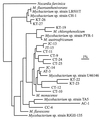Mycobacterium diversity and pyrene mineralization in petroleum-contaminated soils
- PMID: 11319104
- PMCID: PMC92859
- DOI: 10.1128/AEM.67.5.2222-2229.2001
Mycobacterium diversity and pyrene mineralization in petroleum-contaminated soils
Abstract
Degradative strains of fast-growing Mycobacterium spp. are commonly isolated from polycyclic aromatic hydrocarbon (PAH)-contaminated soils. Little is known, however, about the ecology and diversity of indigenous populations of these fast-growing mycobacteria in contaminated environments. In the present study 16S rRNA genes were PCR amplified using Mycobacterium-specific primers and separated by temperature gradient gel electrophoresis (TGGE), and prominent bands were sequenced to compare the indigenous Mycobacterium community structures in four pairs of soil samples taken from heavily contaminated and less contaminated areas at four different sites. Overall, TGGE profiles obtained from heavily contaminated soils were less diverse than those from less contaminated soils. This decrease in diversity may be due to toxicity, since significantly fewer Mycobacterium phylotypes were detected in soils determined to be toxic by the Microtox assay than in nontoxic soils. Sequencing and phylogenetic analysis of prominent TGGE bands indicated that novel strains dominated the soil Mycobacterium community. Mineralization studies using [(14)C]pyrene added to four petroleum-contaminated soils, with and without the addition of the known pyrene degrader Mycobacterium sp. strain RJGII-135, indicated that inoculation increased the level of degradation in three of the four soils. Mineralization results obtained from a sterilized soil inoculated with strain RJGII-135 suggested that competition with indigenous microorganisms may be a significant factor affecting biodegradation of PAHs. Pyrene-amended soils, with and without inoculation with strain RJGII-135, experienced both increases and decreases in the population sizes of the inoculated strain and indigenous Mycobacterium populations during incubation.
Figures




References
Publication types
MeSH terms
Substances
Associated data
- Actions
- Actions
- Actions
- Actions
- Actions
- Actions
- Actions
- Actions
- Actions
- Actions
- Actions
- Actions
- Actions
- Actions
- Actions
- Actions
- Actions
Grants and funding
LinkOut - more resources
Full Text Sources
Molecular Biology Databases
Miscellaneous

